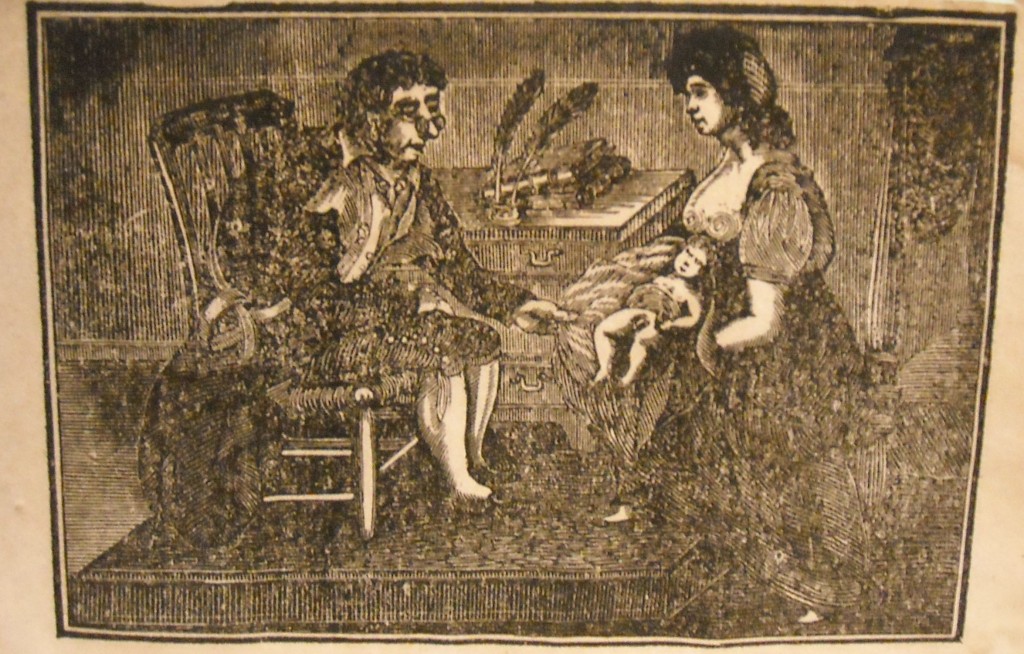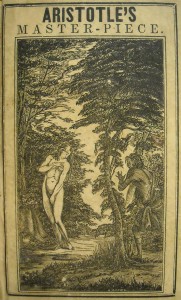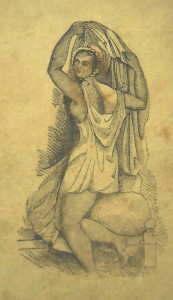The following conundrum for Past is Present readers comes from AAS reader Mary Fissell.
I’m writing a book about Aristotle’s Masterpiece, and have just spent a couple of very productive and happy weeks working with the AAS’s collection of 50+ editions. This book, neither by Aristotle, nor a masterpiece, is one of the longest-running popular medical books on either side of the Atlantic. First published in London on 1684, it was still for sale in sleazy London sex shops in the 1930s. While the text remains surprisingly stable — it is basically a 17th century midwifery book spiced up with a racy poem and half a dozen images of monster babies — the pictures in the book change over time.
For most of the eighteenth century, the picture at the front is of a hairy woman and black baby (see my WMQ article http://www.jstor.org/stable/3491495 for some thoughts on how this image worked), but in the nineteenth century, there’s a riot of new imagery associated with the work. It’s as if the book is a chameleon, taking on the coloration of whatever the publisher thought was trendy and might sell a few more copies. Shortly after their arrival in Boston, Chang and Eng Bunker, the so-called Siamese twins, were featured in the Masterpiece. (See the AAS copies G566 A717 A829 and G566 W926 W831 for examples.) And the borrowing was sometimes two-way; the Masterpiece’s “hairy woman” woodcut was re-used by Nathaniel Coverly in his 1770 Boston edition of the Mary Rowlandson captivity narrative!
Some of the images chosen by publishers or printers have a logic that I can follow — Chang and Eng Bunker fit right in with a text obsessed about unusual births. For others, I can’t figure out what the original image was, and here I beg the help of other readers of cheap print. For example, do any of you recognize this scene?
It’s the frontispiece to an 1831 edition of the Works, the omnibus volume that included the Masterpiece, held at the AAS (G566 W926 W831 Copy 2). What is happening here, and from where did the printer or the bookbinder borrow this scene? The AAS copy is the only one with this image that I have seen — other 1831 New England editions have Chang and Eng Bunker as the frontispiece. Could it be depicting a scene from a novel?
Or take a look at this picture. It’s the cover of an 1842 New York City edition of the Masterpiece (AAS Backlog 19C 0607).
The book looks like a number of other New York editions, seemingly made for a racier readership than many others. But I’d love to know where this image, probably from a painting by Alvan Fisher, came from. Looks like a captivity narrative, perhaps?
And lastly, here’s this lady of dubious virtue, who is the back cover of the same 1842 New York edition. What earlier publication did she adorn?
If you recognize any of these images, or have any ideas about what they may have illustrated originally, please send me an email: mfissell@jhu.edu. I’m very grateful for any leads!



